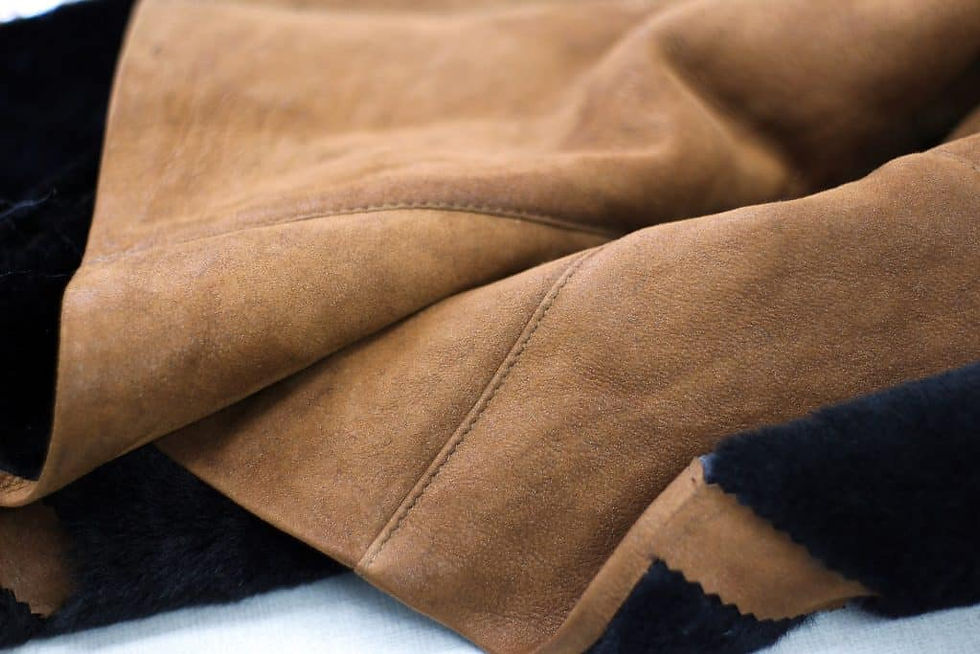How to Clean Leather Upholstery
- Megan

- Jan 29, 2021
- 3 min read
Types of Leather
The first step to cleaning leather upholstery is identifying what type of leather you're working with. While leather is extremely durable certain chemicals and even water may cause damage if the cleaning procedure is done incorrectly. Different types of leather have a semi-protective or fully protective coating that may allow you to clean its surface with slightly different materials.
Types of Leather:
Finished Leathers are practical for active households with children and pets. They are more resistant to fading and discoloration when exposed to light, heat, moisture, dust and body oils. Finished leathers offer the most overall color consistency and generally require less maintenance as spills and stains should clean easily.

Aniline Plus Leathers are aniline leathers with a slight protective coating which may include light pigmentation and or a top clear coat. These leathers are more child and pet friendly than regular aniline, but it still may fade or discolor when exposed to sunlight and temperature extremes.
Aniline Leathers offer rich coloration, natural markings and unique grain patterns. They are more sensitive to sunlight and temperature extremes, and will change in appearance over time.

Nubuck Leathers have the most varied and unique textures. Characterized by a tactile ‘nap’ that you can physically brush with your hand. They have a velvety, suede style appearance and the transparent dyes provide rich saturation of color. Nubuck leather is most susceptible to body oils as they will stain and bind the ‘nap’. They will fade and discolor in response to exposure to sunlight and temperature extremes.
Markings on Leather
Leather can be protected or natural. Protected leathers are better for more trafficked areas, families, pets, etc. Natural leathers require a more delicate environment because the material is meant to wear over time. It is also important to know what exactly to expect with leather material.
Natural leathers often have small character marks which occur naturally throughout an animal's life. These subtle markings on leather are unique and separate them from man-made materials.
Veins
Stretch Marks
Grain Differences
Inconsistency in the Surface of the Leather These are natural marks and are
Brand Marks meant to be there!!!
Insect Bites
Barbed Wire Marks
Wrinkles
Raised Scars with Lighter or Darker Shading

Before beginning to clean inspect your furniture from top to bottom looking for stains, food, and any loose articles like pens that could cause damage Scratches are normal and actually enhance the look of leather. Some minor scratches can be repaired at home. If you find a scratch simply hold a blow dryer (warm not hot) at least 6” away to warm up the natural oils in the leather. Then, using your finger tips, massage the oils into the scratch to help it disappear.
Cleaning Leather
Finished and Aniline Plus:
Open windows to create air flow
Gently wipe down leathers surface (don't spray anything directly at the leather)
Wipe down with soft damp cloth with weak non-acidic soap and water solution (three parts water; one part soap)
Allow air circulation in the room to dry the leather naturally. You may also use a blow dryer, but keep at least 12” away from furniture
If this is performed regularly we recommend applying a leather protective cream to prevent the leather from drying out over time
Aniline:
Use the same method as above with much dryer cloth, barley damp. It is best to first test a small area to insure there is no color removal
Nubuck:
Must use nubuck cleaning kit

There are several different kits available online and special brushes that can help you more easily clean the 'nap'

Cleaning leather upholstery is crucial for preserving its beauty and longevity. Start by dusting with a soft cloth and using a gentle leather cleaner. Avoid harsh chemicals that can damage the leather. For any tears or significant damage, consider a Vinyl Repair Service to professionally restore your upholstery. Regular care ensures your leather furniture remains elegant and durable.